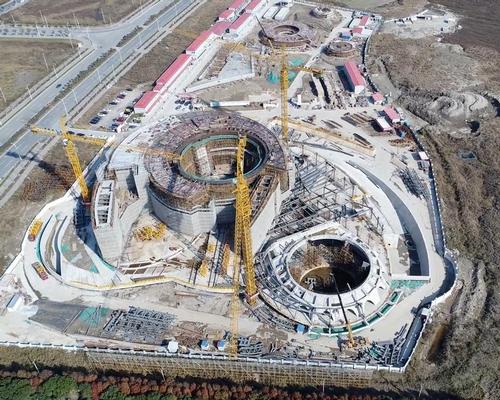20 Mar 2018
Shanghai's stellar planetarium revealed in swooping construction video
BY Kim Megson

A dramatic drone video released by international design studio Ennead Architects has offered a glimpse at their planetarium for the Shanghai Science and Technology Museum taking shape in the Chinese city.
The footage provides a sweeping overview of the 38,000sq m (409,000sq ft) structure as it rises from the ground in the city’s Lingang district. Construction began on the project in November 2016, and completion is scheduled by 2020.
According to Designboom, structural steel components are beginning to be added, including the steel ring truss supporting the 35m (115ft) cantilever and spherical framing of the planetarium itself.
Auxiliary buildings, including two telescope towers, are also beginning to take form, while the exterior cladding of the main facility will take place later this year, paving the way for the exhibition fit-out to begin.
When complete, the facility will explore the mysteries of space, celebrate the history of Chinese astronomy and reflect the future ambitions of China’s space exploration programme. It will feature an optical planetarium, a digital sky theatre, an IMAX cinema, a solar telescope, an observatory and a range of galleries.
Ennead’s competition-winning design draws inspiration from astronomical principles, invoking the experience of orbital motion. Visitors will be guided through each of the building’s three principal forms – the Oculus, the Inverted Dome and the Sphere – that act as astronomical instruments, tracking the sun, moon and stars and reminding visitors that our conception of time originates in distant astronomical objects.
The project is being led by Ennead design partner Thomas Wong and management partner Guy Maxwell.
"In linking the new museum to both scientific purpose and to the celestial references of buildings throughout history, the exhibits and architecture will communicate more than scientific content: they will illuminate what it means to be human in a vast and largely unknown universe," Wong has previously told CLAD.
“We looked at planetaria all over the world, of all eras, and were influenced by many ancient structures including the Aztec pyramids at Teotihuacan, the Pyramids at Giza, Stonehenge and the Temple of Heaven in Beijing. They were all very inspirational in terms of the power they deliver to a culture through built form.”
The design team are targeting both LEED accreditation and a China 3-star rating for the planetarium, which will feature a geothermal heat pump, green roofs and a filtration system that cleans outside air and stormwater.
Drone footage from Lingxiao Xie
Close Window